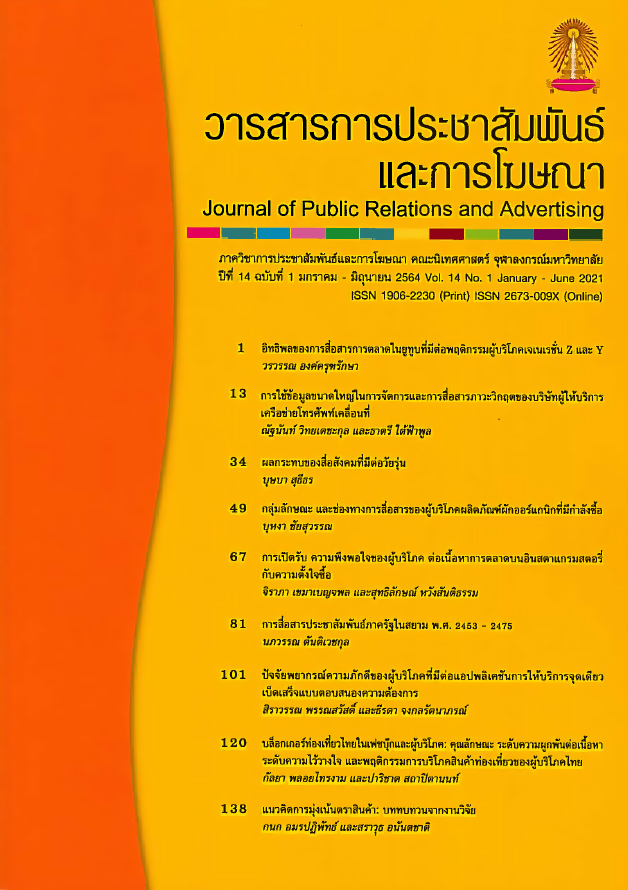The Impacts of Social Media on Adolescents
Main Article Content
Abstract
Adolescence is the transitional phase between childhood and adulthood; a period of some significant changes in physical, mental, emotional, and social behavior acting as basis to develop their self-concept and self-esteem. This paper reviewed relevant literature; aimed to
1) represents the current overall situation of adolescents’ social media usage based on survey result by Ministry of Digital Economy and Society
2) studies the positive and negative impacts of social media on the adolescents. The research findings are 1) the current overall situation of adolescents’ social media usage tends to gradually increase, spending time up to 12 hours on weekends. 2) the positive impact of the social media is that it facilitates and encourages the adolescents to represent their self identities, to build and maintain their interpersonal relationship, to connect with others networking, and to fulfill their needs of information and entertainment. However, due to the long period of time the adolescents spent on social media, reportedly could be up to half the day, the adolescents are at risk of its negative impact as following; impact to their brain, health, mental health. Moreover, the society was affected by the social media. These findings could lead to some suggestions beneficial to parties involved as follows; adolescents, families, schools, and social media content creators; to be aware of the positive and negative impacts of social media and coordinately seek for the solutions to encourage the adolescents to wisely use social media.
Article Details
References
กรมการปกครอง. (2560). สถิติประชากรของกรมการปกครอง. วันที่เข้าถึงข้อมูล 15 พฤษภาคม 2563 แหล่งที่มา https://stat.bora.dopa.go.th/stat/statnew/statTDD/views/showProvinceData.php
กองทุนประชากรแห่งสหประชาชาติ (UNFPA). (2561). รายงานประชากรไทย พ.ศ. 2561: การลงทุนกับเยาวชน. วันที่เข้าถึงข้อมูล 20 เมษายน 2563 แหล่งที่มา https://thailand.unfpa.org/sites/default/files/pubpdf/UNFPA%20Presentation_28-Nov-2017.pdf
กันยา พาณิชย์ศิริและเบญจพร ตันตสูติ. (2559). การติดสื่อสังคมและภาวะสมาธิสั้นของนักเรียน ชั้นมัธยมศึกษาตอนปลายในเขตกรุงเทพมหานคร. วารสารสมาคมจิตแพทย์แห่งประเทศไทย 2559; 61(3), 191-204.
กานติ์ชนิต ผลประไพ. (2563). โรคติดสื่อสังคม. วันที่เข้าถึงข้อมูล 1 พฤษภาคม 2563 แหล่งที่มา https://www.praram9.com/articles/
คมสันต์ เกียรติรุ่งฤทธิ์. (2559). รายการพบหมอรามา ช่วง Big Story ปัญหาการใช้สื่อออนไลน์ของวัยรุ่นกับปัญหาสุขภาพจิต. วันที่เข้าถึงข้อมูล 20 พฤษภาคม 2563 แหล่งที่มา https://www.rama.mahidol.ac.th/ramachannel/home/article/
จิราภรณ์ อรุณากูร. (2560). Media Inspire หนังสั้นสะท้อนอีกมุมมองของ “เด็กติดเกม” วันที่เข้าถึงข้อมูล 2 มิถุนายน 2563 แหล่งที่มา https://www.rama.mahidol.ac.th/ramachannel/home/article/
ชนกชนม์ แต่งเติมวงศ์. (2556). กระแสของ Social Network บนโทรศัพท์มือถือในปัจจุบัน. วารสารสังคมศาสตร์และศิลปะศาสตร์. 2(1), 28-42.
ชมนภัส วังอินทร์. (2561). เสพติดโซเชียล ส่งผลเสีย สุขภาพจิต กาย. วันที่เข้าถึงข้อมูล 14 มิถุนายน 2563 แหล่งที่มา https://www.thaihealth.or.th/Content/42637-
ไทยโพสต์. (2562). สุขภาวะของคนไทยในโลกโซเชียล มนุษย์สองโลกแห่งศตวรรษที่ 21. วันที่เข้าถึงข้อมูล 1 มิถุนายน 2563 แหล่งที่มา https://www.thaipost.net/main/detail/53548
นิชาภา พัฒนกูลชัย, สุวรรณา มณีวงศ์ และอังธนา จุลสุคนธ์. (2561). สื่อสังคมกับสมองของเด็กวัยรุ่น. วารสารวิชาการมหาวิทยาลัยอีสเทิร์นเอเชีย ฉบับวิทยาศาสตร์และเทคโนโลยี. 12(3), 118-123.
นิวส์ 108. (2558). สื่อออนไลน์ประโยชน์เยอะ ภัยร้ายแยะ. วันที่เข้าถึงข้อมูล 3 มิถุนายน 2563 แหล่งที่มา https://www.dga.or.th/th/content/890/1904/
ผู้จัดการออนไลน์. (2562). ยุคโซเชียล ทำยอดนักพนันออนไลน์วัยโจ๋พุ่ง. วันที่เข้าถึงข้อมูล 17 พฤษภาคม 2563 แหล่งที่มาhttps://mgronline.com/qol/detail/9620000021561
พนม คลี่ฉายา. (2559). การใช้งาน ความเสี่ยง การรู้เท่าทันสื่อดิจิทัล และแนวทางการสอน เพื่อการรู้เท่าทันสื่อดิจิทัล สำหรับนักเรียนมัธยมในประเทศไทย ระยะที่ 2. (รายงานผลการวิจัย) สำนักงานกองทุนสนับสนุนการวิจัยและจุฬาลงกรณ์มหาวิทยาลัย วันที่เข้าถึงข้อมูล 21 สิงหาคม 2563 แหล่งที่มา https://dric.nrct.go.th/Search/ShowFulltext/2/302670
พิจิตรา เพชรเภรี. (2562). ใช้เวลาบนโลกออนไลน์ "มากเกินไป”ส่งผลอย่างไรกับตัวเรา. วันที่เข้าถึงข้อมูล 25 พฤษภาคม 2563 แหล่งที่มา https://www.thaihealth.or.th/Content/47053-
มธุรดา สุวรรณโพธิ์. (2563). วัยรุ่นติดโซเชียล. วันที่เข้าถึงข้อมูล 3 มิถุนายน 2563 แหล่งที่มา http://new.smartteen.net/infographic/106
ยุพา พูนขำ, ประกายดาว พรหมประพัฒน์, กอบกุล ไพศาลอัชพงษ์ และ รณภูมิ สามัคคีคารมย์. (2553). การศึกษาแนวทางการส่งเสริมสุขภาพ ป้องกันพฤติกรรมเสี่ยง และปัญหาสุขภาพ เยาวชน. วันที่เข้าถึงข้อมูล 12 เมษายน 2563 แหล่งที่มา http://rhold.anamai.moph.go.th/all_file/research/text_new_rev160855[1].pdf
รักเกียรติ พันธุ์ชาติ. (2560). สื่อสังคม: แนวทางการนำมาประยุกต์ใช้กับหน่วยงานของรัฐ. วันที่เข้าถึงข้อมูล 13 พฤษภาคม 2563 จากhttp://www.dsdw2016.dsdw.go.th/doc_pr/ndc_2560-2561/PDF/
รายงานการพัฒนาเด็กและเยาวชน. (2560). กรมกิจการเด็กและเยาวชน กระทรวงการพัฒนาสังคมและความมั่นคงของมนุษย์. วันที่เข้าถึงข้อมูล 20 เมษายน 2563 แหล่งที่มา https://www.dcy.go.th/webnew/upload/download/file_th_20181211144021_1.pdf
วรพงษ์ เธียรอุกฤษฏ์. (2561). “Social medias ทำอะไรกับสมองของลูกคุณ”. วันที่เข้าถึงข้อมูล 7 พฤษภาคม 2563 แหล่งที่มา https://medium.com/@worapongtearneukit/social-medias-
สำนักงานพัฒนาธุรกรรมทางอิเล็กทรอนิกส์ กระทรวงดิจิทัลเพื่อพัฒนาเศรษฐกิจและสังคม. (2562). การสำรวจพฤติกรรมผู้ใช้อินเทอร์เน็ตในประเทศไทย. วันที่เข้าถึงข้อมูล 1 มิถุนายน 2563 แหล่งที่มา https://www.etda.or.th/publishing-detail/thailand-internet-user-behavior-2019.html)
สำนักงานราชบัณฑิตยสภา. (2556). ความหมาย social media สื่อสังคม. วันที่เข้าถึงข้อมูล 7 พฤษภาคม 2563 แหล่งที่มา http://www.royin.go.th/?knowledges=
สำนักส่งเสริมและพัฒนาสุขภาพจิต กรมสุขภาพจิต กระทรวงสาธารณสุข. (2559). องค์ความรู้การดำเนินงานดูแลสุขภาพวัยรุ่นแบบบูรณาการ สำหรับทีมนักจัดการสุขภาพวัยรุ่น (Teen Manager). กรุงเทพฯ: บียอนด์พับลิสชิ่ง. วันที่เข้าถึงข้อมูล
มิถุนายน 2563 แหล่งที่มา https://www.chiangmaihealth.go.th/cmpho_web/document/161026147747019361.pdf
เสาวนี ชินนาลอง, บุษบา สุธีธร และ สุกานดา วรพันธุ์พงศ์. (2562). ระดับการรู้เท่าทันสื่อใหม่และพฤติกรรมการใช้เฟซบุ๊กและไลน์ของนักศึกษาระดับปริญญาตรี สาขาวิชานิเทศศาสตร์ มหาวิทยาลัยสุโขทัยธรรมาธิราช. (รายงานผลการวิจัย). นนทบุรี : มหาวิทยาลัยสุโขทัยธรรมาธิราช.
ETDA Thailand. (2560). รายงานสรุปสถานการณ์สื่อออนไลน์กับเด็กและเยาวชนไทย. วันที่เข้าถึงข้อมูล 20 เมษายน 2563 https://www.facebook.com/ETDA.Thailand/posts/1958300094183557/
VVP. (2562). ผลการสำรวจ “Global Digital (2019)” วันที่เข้าถึงข้อมูล 13 พฤษภาคม 2563 แหล่งที่มา https://www.marketingoops.com/reports/global-and-thailand-digital-trend-2019/
We are Social. (2563). สถิติการใช้อินเทอร์เน็ตของประเทศต่าง ๆ ในโลก ปี 2563. วันที่เข้าถึงข้อมูล 5 เมษายน 2563 แหล่งที่มา https://wearesocial.com/digital-2020
Gwenn Schurgin O'Keeffe, Kathleen Clarke –Pearson. (2011). Clinical. Report The Impact of Social Media on Children, Adolescents, and Families. Pediatrics (the official journal of the American Academy of Pediatrics) published online Mar 28, 2011; DOI: 10.1542/peds.2011-0054
Jenkins, H. & Purushotma, R. & Weigel, M. & Clinton, K. and Alice J. R. (2006). Confronting the challenges of a participatory culture: media education for the 21th century. The John D. and Catherine T. MacArthur Foundation. Retrieved May 2, 2020 from http://mitpress.mit.edu/books/full_pdfs/Confronting_the_Challenges.pdf
Kennedy, K. (2019). Positive and negative effects of social media on adolescent well-being. [Master’s thesis, Minnesota State University, Mankato]. Cornerstone: A Collection of Scholarly and Creative Works for Minnesota State University, Mankato.
Literat, I. (2014). Measuring New Media Literacies: Towards the development of a comprehensive assessment Tool. Journal of Media Literacy Education, 6(1), 15-27.
Miller, Vincent. (2011). Understanding Digital Culture. London. Sage Publication Ltd.
Silver, Katie (2018). Adolescence now lasts from 10 to 24, BBC News. Retrieved 1 July 2020 from https://www.bbc.com/news/health-427324
World Health Organizer. (2018). Adolescent health in the South-East Asia Region. Retrieved 1 June 2020 from https://www.who.int/southeastasia/health-topics/adolescent-health


